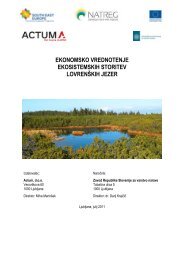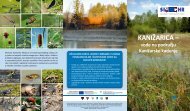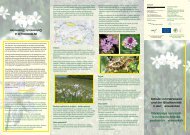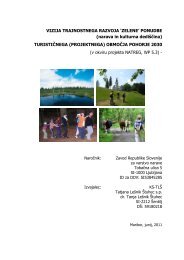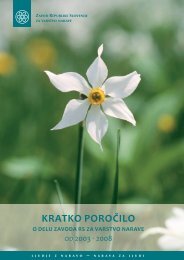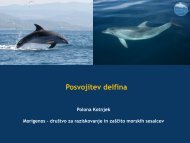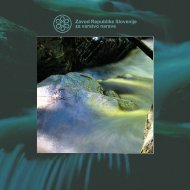marine protected areas in slovenia - Zavod RS za varstvo narave
marine protected areas in slovenia - Zavod RS za varstvo narave
marine protected areas in slovenia - Zavod RS za varstvo narave
You also want an ePaper? Increase the reach of your titles
YUMPU automatically turns print PDFs into web optimized ePapers that Google loves.
168 Barbara Vidmar, Robert Turk: Mar<strong>in</strong>e <strong>protected</strong> <strong>areas</strong> <strong>in</strong> Slovenia: ...4. CONCLUSIONSGo<strong>in</strong>g back to the question <strong>in</strong> the title of the present paper and the 2012/2020 target of anetwork of representative and efficiently managed <strong>mar<strong>in</strong>e</strong> <strong>protected</strong> <strong>areas</strong>, we can concludethat the goal of a network of comprehensive, representative and effectively managed national<strong>mar<strong>in</strong>e</strong> <strong>protected</strong> area system <strong>in</strong> the Slovenian sea is still out of reach. In spite of the fact thatan important part of the typical <strong>mar<strong>in</strong>e</strong> and coastal habitat types are <strong>in</strong>cluded <strong>in</strong> the exist<strong>in</strong>g<strong>protected</strong> <strong>areas</strong>, there are important elements of <strong>mar<strong>in</strong>e</strong> and coastal biodiversity that are stillwithout protection and thus without suitable conservation measures. The percentage of theSlovenian sea covered by <strong>protected</strong> <strong>areas</strong> speaks for itself – 0.4%. Unfortunately it is <strong>in</strong> l<strong>in</strong>ewith the numbers related to the Gulf of Trieste and to the Northern Adriatic, as well as to thewhole Adriatic – whatever the area, the percentage does not exceed 0.5% (Turk et Odorico2009).Accord<strong>in</strong>g to the exist<strong>in</strong>g knowledge on the state of <strong>mar<strong>in</strong>e</strong> and coastal species and habitattypes <strong>in</strong> the Slovenian sea, protection or suitable conservation measures should be granted atleast for the follow<strong>in</strong>g <strong>areas</strong>: the broader area of Debeli rtič, the salt meadows of sv. Nikolaj,the posidonia meadow <strong>in</strong> Žusterna, the stony coral reefs <strong>in</strong> front of Cape Ronek <strong>in</strong> Strunjanand the reef between Fiesa and Strunjan, the dead matte of posidonia outside the Bay of Piran.The last could be <strong>in</strong>cluded <strong>in</strong> a broader area of open waters outside Piran, Strunjan and Izola,devoted to the conservation of the Bottlenose Dolph<strong>in</strong> and the Loggerhead Turtle and possiblyto the endangered chondrichthyan species.The second set of the activities, needed <strong>in</strong> the pursuit of the 2012/2020 target at theSlovenian national level, would have to tackle the management of the exist<strong>in</strong>g (and future)<strong>protected</strong> <strong>areas</strong>. The current situation could be def<strong>in</strong>ed as satisfactory as far as it concernsthe terrestrial parts of the coastal <strong>protected</strong> <strong>areas</strong>, while it is completely unsatisfactory <strong>in</strong> the<strong>mar<strong>in</strong>e</strong> <strong>areas</strong>. There is no management at all <strong>in</strong> the two natural monuments of Debeli rtič andRt Madona, while the management activities <strong>in</strong> Strunjan Nature Reserve are still at their verybeg<strong>in</strong>n<strong>in</strong>g. Due to the fact that the absence of management of the exist<strong>in</strong>g <strong>protected</strong> <strong>areas</strong> iscoupled with the “development orientated” governance of the coastal area, there is a strongpossibility of a further loss of <strong>mar<strong>in</strong>e</strong> coastal biodiversity. A major effort would be needed <strong>in</strong>the near future <strong>in</strong> order to def<strong>in</strong>e appropriate adm<strong>in</strong>istrative, f<strong>in</strong>ancial and technical solutionsfor the management of <strong>mar<strong>in</strong>e</strong> <strong>protected</strong> <strong>areas</strong>.Beside the need for new, properly managed <strong>mar<strong>in</strong>e</strong> <strong>protected</strong> <strong>areas</strong> that would, togetherwith the exist<strong>in</strong>g ones, encompass the great majority of the typical <strong>mar<strong>in</strong>e</strong> and coastal habitattypes as well as habitats of rare and endangered species, there is a third field of activities orstrategies that are equally crucial for the achievement of the 2012/2020 goal. The reductionof negative impacts of human activities, <strong>in</strong>clud<strong>in</strong>g the reclamation of degraded parts of thecoastl<strong>in</strong>e, the susta<strong>in</strong>able use of resources and the <strong>in</strong>tegrated coastal zone management arenot necessarily directly l<strong>in</strong>ked to the <strong>protected</strong> <strong>areas</strong>, but they do, however, play an importantrole <strong>in</strong> halt<strong>in</strong>g <strong>mar<strong>in</strong>e</strong> biodiversity loss. They will have to be tackled <strong>in</strong> parallel at two levels,through sectorial long-term strategies and through physical plann<strong>in</strong>g or, better, through thenewly developed maritime spatial plann<strong>in</strong>g process.



